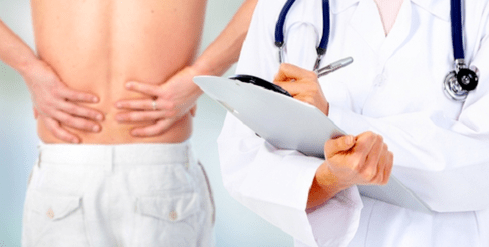Sudden, acute, painful, or dull lower back pain radiating to the legs, the cause of which cannot always be determined immediately, can indicate the development of various diseases. Only an experienced doctor can understand the exact cause of the pain syndrome after examining the clinical picture, the patient's symptoms, as well as the results of ultrasound, X-ray or MRI examinations and analyzes. But often a person wants to know what their condition is related to before going to the doctor.

The main causes of lumbar pain
First of all, all causes of back pain can be divided into two main types:
- Primary (pain is closely related to the pathology of the spine, intervertebral discs, muscle tissue or joints).
- Secondary (pain occurs with diseases of the internal organs and is administered in the lower back, as well as due to infectious diseases in the body, the development of tumors).
Main causes of back pain
Today, two-leggedness is said to be the cause of all diseases of the spine. The load on the spine increases sharply with an upright posture, especially in the lower area - the lumbar spine, which wears out faster.
The main main causes of back pain are:
- Lumbar spine osteochondrosis. Degenerative changes in the spine cause acute pain, inflammation, swelling in the affected area, movement disorders. Characteristic changes in the cartilage tissue of the intervertebral discs and the vertebral bodies themselves often lead to an entrapment of the nerve, which manifests itself in acute pain.
- Spondyloarthrosis. This pathology affects the joint tissues in the area of the spine. In addition to joint pain, a person with spondyloarthrosis can experience severe stiffness of movement when it is impossible to straighten up or rotate.
Lower back pain caused by osteochondrosis or spondyloarthrosis requires urgent, immediate medical attention, and of course, prompt treatment.
Secondary low back pain
A variety of diseases that are not associated with pathological processes in the spine can cause uncomfortable back pain.
There are secondary causes of back pain such as:
- Curvature of the spine (scoliosis, lordosis, etc. );
- Infections of various origins affecting the intervertebral discs (tuberculosis, etc. );
- Urinary system infections and the consequences of influenza;
- inflammatory processes in the genital area;
- Gastrointestinal diseases (appendicitis, pancreatitis, cholecystitis, intestinal colic);
- Kidney disease;
- oncological diseases localized in the peri-lumbar region;
- Obesity;
- Osteoporosis, acute rheumatism, chronic arthritis;
- prolonged standing or sitting;
- Muscle cramp;
- nervous tension, stress.
Internal organ disorders have their own vivid symptoms that are only reflected in the lower back.
Causes of Low Back Pain in Women and Men
The structure of the female body predisposes to the appearance of heaviness and pain in the lumbar region. This is due to the hormonal background: the menstrual cycle, menopause and pregnancy all affect the lumbar region because the reproductive organs are in close proximity. Gynecological diseases (inflammation of the limbs and uterus) cause referred lower back pain in women.
Similarly, prostatitis and inflammation of the epididymis cause pain in men. It happens that with constant work in the cold, with drafts, men regularly have back pain or when the work is associated with lifting weights. Such causes of back pain require preventive measures: you need to warm your back and wear a special corset.
Muscle clamps
Regardless, I'd like to touch on a moment like muscle spasms, which are often the cause of lower back pain. A constant lack of physical activity leads to the fact that the back muscles are weak and cannot withstand prolonged or increased loads. Therefore, working on the legs or sitting motionless leads to overuse of the back muscles and pain.
Stress has the same effect when muscle tension arises from feelings of fear or anger. Cramps and pain follow if they are not eliminated in time.
Concomitant symptoms
Lower back pain, the cause of which lies in the injury to the spine, is most often accompanied by the following symptoms:
- Discomfort can not only cover the back, but also move to the buttocks and lower limbs;
- Movement can be very difficult or completely impossible;
- the affected area is usually inflamed and swollen.
If you have any of these symptoms, you need to see a neurologist. If you have other accompanying symptoms, it is better to contact a therapist who will determine the causes of back pain and then refer you to a specialist doctor or prescribe treatment.














































